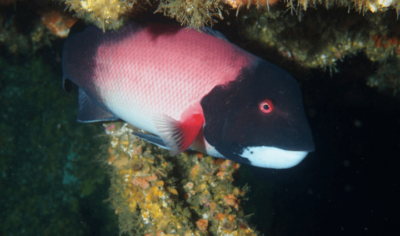
Ever seen a fish cake before? This one might look a little unusual. It’s one of the most exciting fish to find on a snorkel (or as your birthday cake), called the California sheephead (Semicossyphus pulcher). Sheepheads can grow to be over thirty five pounds and a full three feet long. They can live over 30 years and they play an important role in marine ecosystems by eating sea urchins that might otherwise eat all the kelp. However, their lifecycle is the reason why sheepheads often take the cake as most interesting fish. If you’re looking for a fish to satisfy your intellectual hunger, check out the California sheephead!
Sheepheads are all protogynous hermaphrodites, meaning they all start out female with the potential to morph into a male later on in life. When they hatch, juvenile sheepheads have bright red bodies with a white stripe across their body and black splotches on their fins. As they grow, the white stripe fades and the fins lose the black spots, becoming entirely red while their lower jaw turns white. A sheephead can have vivid colors like bright red or more subdued tones such as a pale pink. After growing from anywhere from six to twelve years, a sheephead can finally change into a male!
The change from male to female varies between individual fish. Usually a female can morph into a male when there are no other males living nearby (or not enough males) and she is the most dominant of the females in the area. Dominance can be established by big mouth competitions – two sheepheads will swim at each other while opening their mouths as wide as possible, sometimes even locking jaws. However, other factors can influence whether or not this change occurs, including where the sheephead lives, how large she is, how quickly she grows, when she matured, and the amount of fishing in the area. Sometimes, slower growing females will never change.
If a female successfully starts morphing into a male, it’s no cakewalk. There are a couple changes she’ll experience. Her body colors adjust: her torso remains red but her caudal fin (tail fin) and head turn black, except for the chin. Talk about a five o’clock shadow! The fish also grows a large hump on the forehead. Finally, the sheephead’s reproductive organs change due to changing hormones. The ovaries reabsorb any eggs inside while transforming into testicular tissue. Then, the newly male sheephead can claim his own territory and begin life as a male!
References:
Hamilton, Scott L., Jennifer E. Caselle, Julie D. Standish, Donna M. Schroeder, Milton S. Love, Jorge A. Rosales-Casian, Oscar Sosa-Nishizaki, 2007. Size-Selective Harvesting Alters Life Histories of a Temperate Sex-Changing Fish. Ecological Applications, 17(8), 2268-2280.
Loke-Smith, Kerri A., 2007. 15 California sheephead, Semicossyphus pulcher. Status of the Fisheries Report, 2011.
Love Milton.
Warner, Robert B., 1975. The Reproductive Biology of the Protogynous Hermaphrodite Pimelometopon pulchrum (Pisces: Labridae). Fishery Bulletin 73(2).


